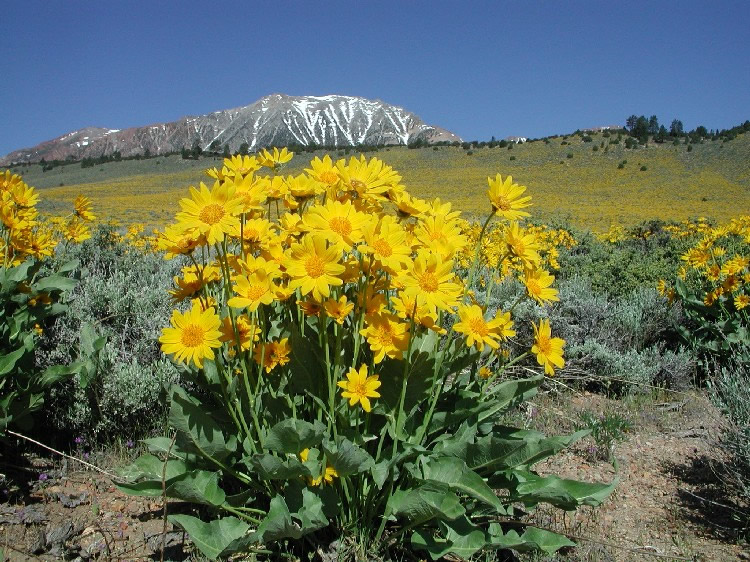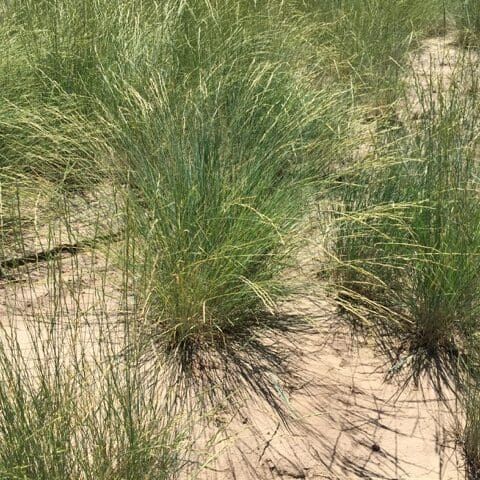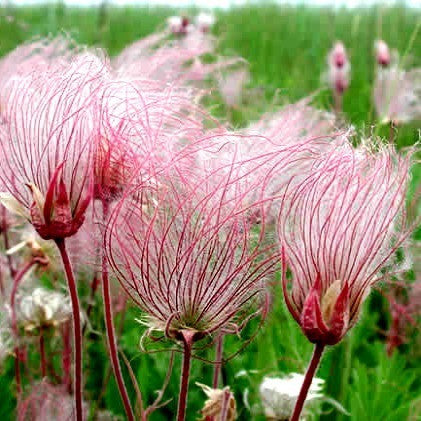This native wildflower, with bright yellow, daisy-like flowers, is commonly found in the Palouse Prairie and is known for its drought tolerance.

What is Arrowleaf Balsamroot (Balsamorhiza sagittata) ?
This small, non-migratory songbird is easily recognized by its distinctive black cap and bib, contrasting with its white cheeks. Found in the Palouse Prairie, it's known for its cheerful "chick-a-dee-dee-dee" call
What is a Black-capped Chickadee
This fine, wind-blown sediment, which accumulated over thousands of years, forms the primary soil type in the Palouse Prairie and contributes to its fertile, rolling hills.
What is loess?
This sacred plant, harvested by the native people of the Palouse Prairie, was an important food source and is known for its blue, star-shaped flowers and edible bulbs.
What is camas?
This invasive grass, originally from Eurasia, spreads rapidly and outcompetes native plants. It is known for its early green growth and ability to withstand drought conditions.

What is Cheatgrass (Bromus tectorum)?
This tall, perennial bunchgrass, known for its deep roots and ability to thrive in dry conditions, is one of the most dominant grasses in the Palouse Prairie ecosystem.
What is Bluebunch Wheatgrass (Pseudoroegneria spicata) ?
This striking bird, often found perched on cattails and reeds, is recognized by the male's distinctive red and yellow shoulder patches, and its distinctive "conk-la-ree" song. It's a common sight in wetlands and marshes of the Palouse Prairie.
What is the Red-winged Blackbird?
These massive floods, occurring at the end of the last Ice Age, carved out much of the landscape of the Palouse Prairie and left behind distinctive features such as coulees and dry falls.
What are the Missoula Floods?
This indigenous group, whose traditional homeland includes the Palouse Prairie, is known for their horse culture and rich agricultural practices, particularly the cultivation of camas root.
Who are the Nez Perce?
This invasive annual grass, native to Europe and northern Africa, has become a significant problem in the Palouse Prairie due to its rapid spread and ability to outcompete native vegetation, leading to reduced forage quality and increased soil erosion.
What is Ventenata dubia ?
This drought-tolerant plant, with striking orange to red flowers, is often found in the grasslands of the Palouse Prairie and is a favorite among hummingbirds and other pollinators.

What is Indian Paintbrush (Castilleja)?
This bird is known for its distinctive "broken-wing" act, which it uses to distract predators away from its nest. It has a brown upper body, white underparts, and a striking double black band across its chest.
What is the Killdeer?
This highest point in the Palouse Prairie stands at approximately 5,470 feet and is located near Colfax, WA, providing a stunning view of the surrounding landscape
What is Steptoe Butte?
This river, running through the Palouse Prairie, was a vital resource for the native people, providing fish, water, and transportation routes.
What is the Palouse River?
This invasive plant, also known as Bachelor's Button or Blue Cornflower, is native to Europe and Asia. It produces a large number of seeds that spread easily, allowing it to outcompete native plants and disrupt local ecosystems in the Palouse Prairie.
What is Bachelor's Button (Centaurea cyanus)
This native wildflower, with fluffy bright pink to purple flowers and long, narrow leaves, is commonly found in the Palouse Prairie and attracts a variety of pollinators.

What is Prairie Smoke (Geum triflorum)?
This small, slender bird is known for its reddish-brown cap, white eyebrows, and distinctive black line through its eye. Often found in open woodlands and grassy areas, it has a characteristic trilling song that resonates through the Palouse Prairie.
What is the Chipping Sparrow?
These ancient volcanic eruptions, occurring approximately 17 to 15 million years ago, created vast lava flows that underlie much of the Palouse Prairie region.
What are the Columbia River Basalts?
This traditional fishing method, used by the native people of the Palouse Prairie, involved constructing weirs and traps in rivers to catch salmon and other fish.
What is fishing with weirs and traps?
This invasive plant, also known as Goat's Beard, is native to Europe and has distinctive yellow or purple flowers. It spreads quickly and can form dense stands, outcompeting native vegetation and disrupting local ecosystems in the Palouse Prairie.

What is Salsify (Tragopogon porrifolius)?
This native perennial herb, with delicate blue flowers and narrow, grass-like leaves, is commonly found in the Palouse Prairie and is known for its striking appearance and ability to attract pollinators
What is Blue Flax (Linum lewisii)?
This slender, long-winged raptor is often seen gliding low over grasslands in search of small mammals. The males are gray with black wingtips, while the females are brown. They are distinguished by a white rump patch and a face that resembles an owl’s.
What is the Northern Harrier?
This dramatic geological feature, created by the powerful Missoula Floods, is a series of steep-walled canyons carved into the basalt bedrock of the Palouse Prairie.
What are the Channeled Scablands?
This famous Nez Perce leader, known for his efforts to peacefully resist U.S. government policies and protect his people's homeland, played a significant role in the history of the Palouse Prairie.
Who is Chief Joseph?
This highly toxic invasive plant, native to Europe and North Africa, has tall, hollow stems with purple blotches and small white flowers arranged in umbrella-like clusters. It poses a significant threat to livestock and wildlife in the Palouse Prairie.

What is Poison Hemlock (Conium maculatum)?